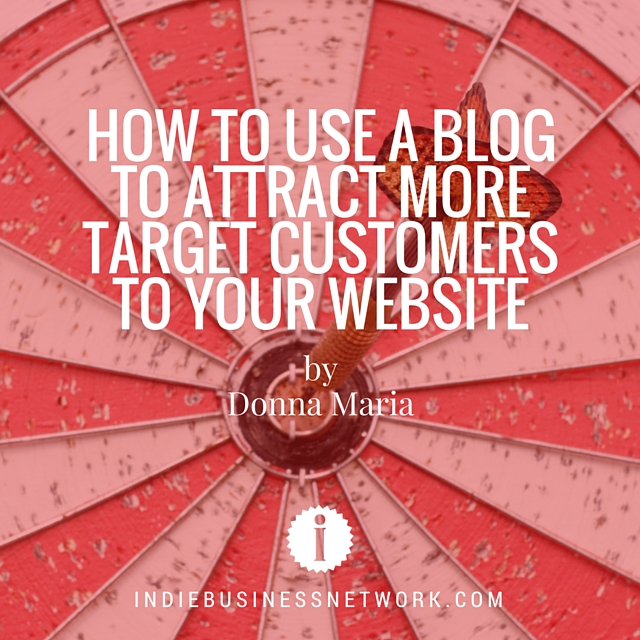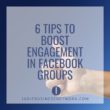As you probably know, I'm a big believer in the power and wisdom of using a blog to attract more customers to your website. Attracting customers is not the only reason I believe blogging is critical to your success as an entrepreneur (here are other reasons), but it's one of the big ones.

After nearly 16 years in business, I have concluded that there is no better effective and sustainable means of attracting people to a website than a blog. It's the reason why you'll find over 1,800 articles at this blog, and the reason why there will be at least another 1,800 before I'm done.
For beginners, blogging is mysterious and scary. I know, because I was once a beginner blogger.
If you are new to blogging, this article will take some of the mystery out of the process. If you're a seasoned blogger, it will provide a good review of the basics that are critical to your continued success.
Here is how you can use your blog to attract more target customers to your website.
”
Donna Maria Coles Johnson, Indie Business Network
- Have a good product targeted at a specific niche.The first thing you need for a successful blog is also the first thing you need for a successful business: a product aimed at a particular niche audience.It's not enough to have a wonderful product. Everyone has a wonderful product.You must be able to connect that product to a particular type of customer, and your blog must complement and support that connection.Blogging about the kitchen sink and everything in it won't work. Before you start blogging, make sure you have have identified the target audience for your product so you can create content at your blog that will appeal directly to them.
- Use WordPress.I have used Movable Type, Typepad, and WordPress for my blog, and WordPress is the best by far.It's easy to use and customizeable. Yes, there is a learning curve, but isn't there always?If you use a different blogging program, switch to WordPress.org. Do not use WordPress.com, because your blog URL will be something like abcxyzcompany.wordpress.com. That is not so good. You want your blog URL to be abcxyzcompany.com/blog because it's easy to remember and looks great on your business cards and other marketing collateral.All of the plugins and resources recommended in this post are compatible with WordPress, since that's what I use.
- Learn to write well.I hear all of those moans and groans out there. Sorry. There is just no way around this. Even if your blog attracts your target customer, she will bounce off your site like a rubber band if the articles are not well written and easy to skim.Each blog post should have a good headline that summarizes the gist of the post.Generally, each post should cover one topic. If a post contains too many topics, it will be hard to digest and people will give up.A blog post should be skimmable with plenty of line spaces and/or numbers and/or headers (like this one has) so people can quickly glance through it for salient points, and then settle in to actually read if desired.
Each blog post should include a large and relevant graphic to anchor the content. Big visuals help draw people in.
Check spelling and grammar, and read and re-read your post before publishing to make sure it flows and creates a pleasant experience for your readers.
- Blog consistently.Don't get all excited about blogging, then blog your brains out for three months, and then stop. What kind of message does that send to the world? Certainly not one that says, “You can trust us to be here next year.”Blog at least once a week. You can do more if you want, but publish a post at least once a week. To make it easy on yourself, pick a day of the week and schedule however much time you need to get it done and out the door. It's the least you can do to let your customers see you alive and kicking, and reaching out into the universe to call their name with your unique message.
- Focus on blogging in specific categories. If you look in the upper right corner of the sidebar here at Indie Business Blog, you'll see that I blog about specific types of things, among them Social Media, Entrepreneurship, Leadership, and Success.I blog to attract a particular type of person who is interested in those things. I do not blog to attract everyone, nor do I offer my services to everyone. (See Number 1, above.)Maintaining categories at your blog helps you to narrow down blog topics, and helps your site visitors find the things they are most interested in.
- Link your blog (and blog posts) to your online shop.Your blog should contain links to things people can buy in your store. These links can be in the sidebar, in a pop up window, in the footer, or in the body of blog posts themselves. In fact, they should be in all of these places, but you should mix it up a bit.For example, check out our member Joan Morais' blog, which has a sidebar allowing you to click on things you can purchase, including books and courses.
There's also Celtic Complexion's blog, where the top navigation product category links appearing on each blog page make it easy for you to click on the products you are interested in.
You can (and should) also blog about your products.
Yes, you can write a post about how great they are, with a link, and that works. But you can also be more creative than that, like this post from our member over at Outlaw Soaps, which boils the 2-hour soapmaking process down to a 5 minute video. There is no call to action to buy her soap in the post or the video, but she doesn't need it. The video invites you to check out the soap without being asked. And whether you scroll up to the top navigation or down to the footer, you'll also find links to buy her products.
- Make it easy for people to share your posts.See the share links at the top and bottom of my blog? They make it easy for you to share my content. (Thank you very much!) They also make it easy for me to share my content, which is very important.Every time I publish a post, I take an extra two minutes to share it using those links to LinkedIn, Google Plus, and Pinterest.
I manually share on our Twitter because I like to share the graphic with the post (like this).I manually share on our Intagram (because it's super easy with my cell phone in my hand) for the same reason.
From time to time (not always), I share posts on my personal Facebook page.
My assistant shares to the Indie Business Network Facebook Page.
I use the Genesis Simple Share Plugin for this, but there are others.
If you don't make it easy for people to share your content, guess what? They won't share your content.
Another way to do this is with the the Click To Tweet plugin, which you can see in action below.
“
”
Donna Maria Coles Johnson, Indie Business NetworkClick it, and you'll see that it opens a new page to your Twitter. If you are logged in to Twitter, you can easily click to Tweet the quote from your account. The text is pre-populated for you, and it tags the Indie Business Network Twitter account. It gives your readers a fun way to share something that resonates with them, and all roads lead back to you.
- Make it easy for people to comment on your blog posts.Make a place for people to comment and leave feedback at the bottom of your posts. WordPress has a native comment plugin you can use. You can also use the Disqus commenting system. I have used both, and while I prefer Disqus, I recently removed both from my blog because I want to encourage people to comment via Facebook and/or via sharing on LinkedIn, Facebook and/or Twitter.While I like comments at my blog, the real community is out there where you spend most of your time. My blog is geared to capitalize on that.
However you decide to encourage people to comment, do not require them to log in or type in a Captcha of any kind. Rather than help you with spam, they just act as just barriers to engagement, and they make most people crazy. Use a spam filtering plugin like Akismet, which will filter out nearly all of your spam.
- Comment on other blogs.As time permits, leave comments at other people's blogs. This helps you leave little bread crumbs across the Web, which ultimately lead back to your website. The other thing you gain by doing this is the constant inspiration to make your blog better. You'll never have to wonder what the latest plugins and blogging techniques are because we will be learning and using them together in the group.At the Blog Your Brand Facebook Group, I host a weekly blogging campaign designed to train bloggers to improve their blogging skills while making it easy to find blogs that interest you enough to comment on. If you join us there, not only will you get blogging training, but you'll also be surrounded by a supportive community of like-minded entrepreneurs who will help you as you help them. And you'll never have to look for blog posts again — we'll bring them to you in the group!
- Link to posts within and outside of your blog.Take the time to embed links in your new posts to old posts. You can see how I did this in the first paragraph of this post. By linking to other content within your own blog, you reinforce your points and showcase the depth of your expertise in a particular area that supports your business goals. You also give your readers another reason to stay at your blog longer than they otherwise would.Show some link love to others as well. As great as your blog posts are, people do not want to feel landlocked there. Linking out to other resources shows that you are knowledgeable and well read yourself. It also gives you search engine juice because Google likes to link to pages that link to other relevant pages.
- Optimize your blog posts.Use a plugin to optimize each of your blog posts for maximum exposure on search engines. The plugin I use for this is Yoast.After I finish drafting a post, and I give it a title, meta data, etc., the Yoast plugin operates to tell me whether my post is optimized for the Web by giving it a red light, a yellow light, or a green light based on the presence of 14 factors, including things like whether key words are used, whether images contain alt tags with key words, whether there are enough links to other websites, and whether the title and permalink structure are correct.
If I see a red light, I need to fix some things before publishing. If I see a green light, I'm good to go. If I see a yellow light, I fix few things if I'm in the mood and I don't if I'm not.It's an amazingly useful tool, and I cannot imagine blogging without it.
(I got a green light for this post. Yay!)
- Tell people how to subscribe to your blog.I use Feedburner (owned by Google) to allow people to subscribe to my blog via email. You can subscribe to my blog on this page.If I didn't already have a newsletter subscription service, I might sign up for MailChimp, which has an RSS to Email service that aggregates and delivers all of your blog posts to your subscribers in one email message each week. That sounds very handy and I suggest you check it out if you use MailChimp.
Question
Whew! That was a lot, yes? What do you think? Is this useful to you? Don't try to do everything all at once, but if you set aside the time to follow these steps one at a time, you will be blogging like a champ. You'll enjoy more website traffic, and that's the first step to increasing your online sales. Are you ready? What will you do now that you know all of this? I invite you to share your thoughts and feedback in the comments below, or share on Facebook, Twitter and LinkedIn.



